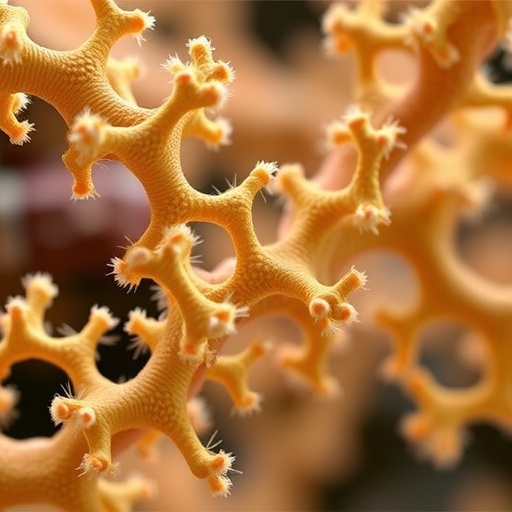In a groundbreaking exploration of cellular resilience, researchers have uncovered the fundamental biochemical and structural properties that enable certain proteins to endure extreme dehydration and subsequently regain functionality upon rehydration. This study, conducted by a multidisciplinary team and recently published in Cell Systems, challenges long-held assumptions about cellular survival and opens new avenues for biotechnology innovation, particularly in the stabilization of protein-based therapeutics.
Water is indispensable for life, constituting the majority of the cellular environment. The sudden removal of water typically leads to irreversible cellular damage and death. However, certain organisms exhibit an extraordinary capacity to survive complete desiccation and rebound once rehydrated. To penetrate the molecular underpinnings of this phenomenon, scientists analyzed thousands of proteins within yeast cells, leveraging both advanced mass spectrometry techniques and artificial intelligence-driven structural analysis tools. This comprehensive profiling elucidated distinct molecular patterns dictating protein stability through the dehydration-rehydration cycle.
The researchers discovered a striking dichotomy among proteins: while the vast majority suffered loss of structural integrity and function after water removal, a subset retained remarkable stability. These dehydration-tolerant proteins consistently shared several defining characteristics. They were generally smaller in size, exhibited compact and tightly folded conformations, and engaged in fewer molecular interactions—factors which collectively foster resilience to the destabilizing effects of dehydration. The surface chemistry of these proteins also played an instrumental role; a high density of negatively charged amino acid residues on the protein exterior emerged as a key protective feature, likely facilitating maintenance of protein solvation and preventing aggregation during water stress.
By dissecting the sequence and structural attributes inherent to this protein subset, the team formulated a conceptual “grammar” of desiccation tolerance—a biochemical lexicon that can be harnessed to engineer proteins with enhanced robustness. To validate this framework experimentally, they introduced carefully selected mutations into the Green Fluorescent Protein (GFP), a biologically important reporter protein known for its sensitivity to dehydration. Remarkably, these targeted modifications transformed GFP into a dehydration-resistant variant, where up to 100% of protein molecules retained their functional conformation and fluorescence following rehydration. This proof-of-principle demonstration heralds a new era in protein engineering, where dehydration resilience can be systematically introduced and optimized.
Further investigation into protein function revealed an evolutionary strategy underpinning cellular survival during water loss. Proteins classified as dehydration-tolerant commonly fulfill “producer” roles within the cell, catalyzing the biosynthesis of essential small molecule precursors and building blocks necessary for subsequent macromolecular assembly. In stark contrast, proteins that succumbed to drying were mostly involved in energetically expensive processes such as ribosome assembly, which consume these precious small molecules at high rates. By selectively safeguarding the producers and allowing the depletion of consumer proteins during desiccation, cells effectively prioritize metabolic pathways critical for rapid recovery upon rehydration.
This strategic allocation of cellular resources resembles a biological triage system, ensuring that foundational metabolic functions are preserved while nonessential or resource-draining activities are suppressed in times of stress. Upon the return of water, tolerant producer proteins rapidly resume activity, replenishing the intracellular milieu with vital building blocks and jumpstarting the cellular machinery. This insight into the functional orchestration of protein survival reflects millions of years of evolutionary pressure shaping cellular resilience mechanisms, an understanding that could redefine our approach to studying stress tolerance.
The implications of this study extend well beyond basic science. Modern biotechnological and pharmaceutical applications stand to benefit immensely from the ability to rationally design proteins capable of withstanding drying stresses. Protein-based therapeutics, including antibodies and enzymes, often require refrigeration and have limited shelf lives. Engineering proteins with intrinsic desiccation tolerance could eliminate cold-chain dependencies, enabling transport and storage under ambient conditions. This would dramatically reduce costs, improve global distribution logistics, especially in resource-limited settings, and enhance drug accessibility. The COVID-19 pandemic underscored these challenges, with vaccine distribution hampered by refrigeration requirements—an issue potentially mitigated by employing dehydration-tolerant protein formulations.
Scientifically, the study introduces a paradigm shift, recognizing dehydration tolerance not as an isolated trait unique to extremophiles but as a feature encoded in the biochemical language of protein structure and chemistry. By decoding this language, researchers can reveal universal principles governing protein stability under abiotic stress. Such knowledge enables the synthesis of novel biopolymers and the custom design of proteins with tailor-made properties for industrial, medical, and environmental applications.
The integration of high-throughput proteomic profiling with machine learning analysis constitutes a powerful methodological advance, allowing the dissection of complex biological phenomena at an unprecedented scale. This approach can be adapted to explore protein stability under other environmental challenges, such as temperature extremes or oxidative stress, further expanding our toolkit for crafting robust biomolecules.
As research progresses, the team aims to apply these insights toward the rational design of synthetic proteins imbued with dehydration tolerance, potentially revolutionizing the production of stable enzymes, vaccines, and diagnostic agents. Moreover, understanding how cells orchestrate their proteome during extreme stress adds a critical layer to our comprehension of cellular homeostasis and adaptation, with prospective relevance to aging, disease states, and synthetic biology.
Ultimately, the elucidation of the biochemical “grammar” of protein survival redefines biological resilience as a chemically encoded principle rather than an extraordinary exception. This breakthrough offers a promising scaffold for future innovations in protein therapeutics, agricultural biotechnology, and beyond, shaping a future where life’s vital molecules can be preserved and deployed in conditions once deemed inimical.
Subject of Research: Protein structural and chemical determinants of dehydration tolerance in yeast cells.
Article Title: Decoding the Biochemical Grammar of Protein Survival Through Desiccation.
News Publication Date: October 2, 2025.
Web References: Cell Systems Article
Image Credits: Syracuse University
Keywords: Chemistry, Agricultural chemistry, Chemical biology, Chemical elements
Tags: artificial intelligence structural analysisbiotechnology protein therapeuticscellular resilience mechanismsdesiccation-tolerant proteinsextreme dehydration survivalmass spectrometry protein analysismolecular patterns protein stabilityprotein folding characteristicsprotein stability dehydrationrehydration recovery processesstructural integrity in proteinsyeast proteins drought resistance





